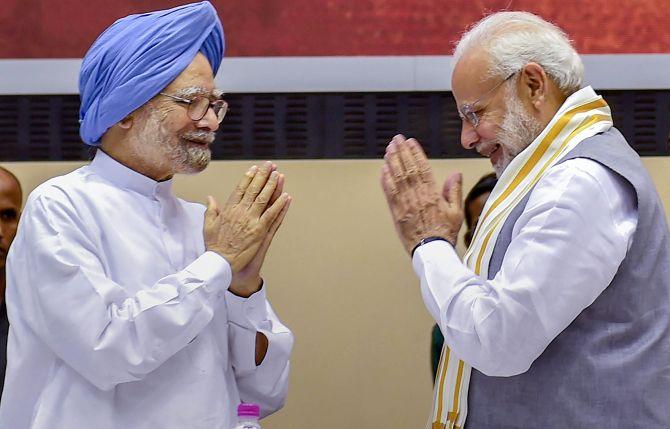 | « Back to article | Print this article |
'The Modi government, like the Singh one, has run into what is called a perfect storm, where everything that can go wrong does so at the same time,' points out T C A Srinivasa-Raghavan.

Think about it.
NDA 2 is finding itself in exactly the same kind of trouble that UPA 2 had done after being re-elected in 2009.
Not a week goes by without some bad news.
The difference is that in the case of the Manmohan Singh government, it was widespread corruption that caused the trouble.
In the case of the Modi government, it is the economy.
The bad news has been unrelenting.
Dr Singh appeared helpless then, and floundered.
Mr Modi also looks helpless now and is floundering.
Dr Singh was not personally corrupt.
Far from it.
But his colleagues let him down.
It's exactly the same with Mr Modi.
After almost six years in power, we don't know what worms are hiding under which rocks.
By 2013, the last full year of the Singh government, economic bad news had also begun to surface.
The man who made the most of it electorally was Mr Modi.
No promise of his was rejected by the voter.
It will be interesting if corruption becomes to the NDA in 2022 what inflation had become to the UPA by 2012.
It's unlikely, but ministerial colleagues can spring nasty surprises.
Dr Singh, in a desperate bid to give the UPA a cleaner image, ordered many inquiries and punitive actions.
None of them helped.
Mr Modi has also ordered -- and will order -- similar desperate actions for the economy.
Time will tell if these help or not.
By late 2012, the non-Congress members of the UPA had given up.
Many of them told me they were looking forward to putting their feet up and, in a manner of speaking, playing with their grandchildren.
The NDA partners are having similar problems with the BJP.
Unity is giving way to diversity.
Political need, it is evident, waits for no one.
It's worth recalling that in 2010 the BJP was in complete disarray and the Congress appeared firmly in the driver's seat.
By 2014, it had been consigned to the dustbin.
What cooked its goose was the perception of incompetence and crookedness.
Perceptions are like that only.
They don't regard facts as sacrosanct.
It is this problem that Mr Modi's government is currently encountering.
The general belief is that it hasn't a clue as to how to tackle the sudden and massive deceleration in the rate of growth of industrial output of the Indian economy.
It accounts for 15% of GDP.
Even when it does the right things, the government is being criticised.
Indeed, the truth is that it's done exactly what economists and other busybodies have been recommending on macro, micro, taxation, and administrative matters.
The speed may be disappointing but the direction is not.
But the mood has turned unforgiving.
Once a perception takes hold, the constraints that governments operate under are seen as mere excuses.
The biggest puzzle is the complete disjunction between the government's political policies and economic policies.
In politics, it gets the big things -- and the associated perceptions -- absolutely right.
That helps it win elections.
This is the opposite of the UPA, which got its economics generally right, at least until Pranab Mukherjee became finance minister.
To date no one knows why he did all that he did.
The Modi government, like the Singh one, has thus run into what is called a perfect storm, where everything that can go wrong does so at the same time.
It's like a boat that springs a simultaneous hundred leaks and also starts running into a gale.
The crew doesn't know whether to bail the water out or plug the holes or trim the sails or open them out.
The current deficiency in demand for industrial goods is like that.
The government is trying to boost both consumer and investment spending, but it's like a crew with too few plugs and towels, as well as a faulty jib.
So what should the government do? It has only one economically sensible option: Reduce expenditure -- which it will because there's no money -- but openly instead of by the Chidambaram method of postponing and hiding it.
Indeed, the problem with depressed consumer and investment sentiment is largely because the government is spending too much, and desperately demanding tax revenue.
It needs to go easy.
In Keynesian terms, it's the G in the national income identity that is holding C and I down, instead of raising them.
This is the precise opposite of what Keynes had thought would happen.
When things stop working as they should, you get the perfect storm.
And when that happens you reduce speed, not bash on regardless.
T C A Srinivasa-Raghavan is a columnist with Business Standard newspaper and the author of Dialogue of the Deaf: The Government and the RBI.